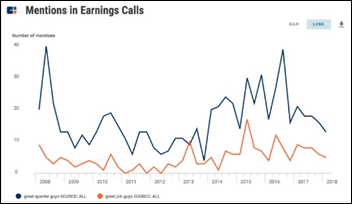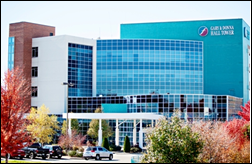Curbside Consult with Dr. Jayne 4/16/18

I’ve written a bit lately about burnout and how it’s impacting people in healthcare IT. A couple of years ago, I took up a hobby that was 180 degrees from my day job. I don’t fancy myself an artist, but it was a way to use my mind in a different way than I typically do while creating projects that others can enjoy, or at least find useful.
The Internet has been a great teacher. I’ve been able to benefit from various teachers who have published videos to help beginners, as well as some who conduct web-based educational sessions. With travel and work responsibilities, I don’t have much time to attend classes or workshops in town, but I keep my eye out for various opportunities. I had heard about a craft retreat more than a year ago and languished on the waitlist for nearly a year, but ended up being able to go this weekend.
I was looking forward to getting away from the informatics rat race and focusing on learning new techniques, meeting new people, and being able to spend some time in a beautiful place recharging my mental batteries. Of course, there was the standard pre-vacation hustle as I tried to tie up all the loose ends before leaving, and I’m not looking forward to the post-vacation shuffle as I work to handle everything that accumulated in my inbox and on my voice mail while I was gone.
Since most of the meetings and conference I go to revolve around healthcare or IT and are held at large convention centers or well-known hotels, I was looking forward to the more casual atmosphere of the state park where it was held (although I did opt for a room in the lodge rather than in a yurt, which was also available.)
When I’m meeting new people in a non-work environment, I don’t advertise that I’m a physician, especially when part of the purpose of doing something like this is to get away from the industry and the stress. People do tend to talk about what they do in their day jobs and I usually say I work with medical office software. I was surprised when the first person I said that to asked if I worked for Epic, since knowing what company is your physician or hospital’s vendor might not be the most common scenario. The woman I was talking to was a nurse who recently retired from a hospital as they transitioned from McKesson to Epic. We talked about burnout in nursing and she mentioned that several other people at the conference that she knew from previous years were also in healthcare.
It turns out that of the 80 or so people at the retreat, more than a dozen were escapees from the healthcare arena. Mostly nurses, with a respiratory therapist, a hospital social worker, and a medical transcriptionist in the mix. It was really a cross-section of people, with 26 states and two countries represented besides the US. The organizers encouraged people to mix it up at meals and breaks. I met a former welder who became disabled after a car accident, a recent MBA grad who found his accounting work “soulless,” and quite a few retirees and semi-retirees who are supplementing their incomes through craft fairs and online shops.
I didn’t hear a peep about healthcare until breakfast on the last day, when someone was talking about flu season and the conversation morphed into a discussion of unanticipated medical expenses. As a physician and as someone who works closely with healthcare organizations in crafting their strategies, it was like watching a focus group without having to recruit people or do the meeting planning. A few minutes into the discussion, I wished that I had a hidden camera to capture the conversation, because it hit on many of the issues that patients face that sometimes we on the administrative, care delivery, and informatics sides don’t understand as well as we might think we do.
As expected, high premiums and high deductibles were topics. One attendee is a teacher in Colorado and is thinking about switching her insurance to a catastrophic plan, but is worried that she can’t get coverage because of her age. She is a fairly savvy consumer, having researched what it would look like to pay cash – and having received a quote from her primary care physician of over $600 for a well visit with some basic lab work. The physician didn’t offer any kind of discount for being self-pay up front, which seemed surprising. She mentioned the practice is hospital-owned, which may be part of the issue. Her plan is to use the urgent care, which charges $99 for an office visit, as her primary until she goes on Medicare.
Other topics included the wackiness of pharmacy benefit management plans, how long it takes to get bills from medical providers, and liking the fact that they could see their lab results on their phones. One attendee at our table was from Canada and spent a bit of time explaining her personal experience with that health system (which was overwhelmingly positive).
Each person had some kind of healthcare story. The general theme is that we in the healthcare business can do better and should be doing better for our patients. I’d love to have hospital executives hear about people’s experience with the cost of healthcare when they are thinking about building that new bed tower or spending tens of thousands of dollars rebranding the hospital. I’d enjoy seeing legislators hear the stories of people who live in rural areas and have to drive hours to see physicians because their states haven’t figured out how to address telemedicine. I’d like to see IT directors and software engineers sit down with people who have retired from caregiver positions because the tools they are expected to use to do their jobs add stress with little benefit. And I’d like to see policymakers interact with people who just want to get the most out of life so they can spend time fishing, crafting, raising their kids, or playing with their grandchildren and keep everyone as healthy as possible.
I’d like to challenge people in healthcare, technology, and administration to get out and interact with the people they serve, whether they serve caregivers, end users, patients, or other parts of the system. Hear their voices directly, not just through marketing and survey data. Understand the challenges they’re facing and what we can do to help. Learn what is working and what is broken in our crazy system.
And while you’re at it, sit by a lake and watch the ripples in the water. Contemplate the value of things other than your stock price or what your shareholders will think. As yourself whether you’re doing the right thing for the people you serve or whether you’re just marking time or playing it safe. Listen to pine needles crunching under your feet. Find something outside of work that challenges you in a different way or makes you feel happy and fulfilled. It might just give you a new perspective when you go back to your day job.
How do you recharge your emotional batteries? Leave a comment or email me.

Email Dr. Jayne.




































































The $50 billion Rural Health payout is welcome. In context, it's less than the total cost of the F22 raptor…